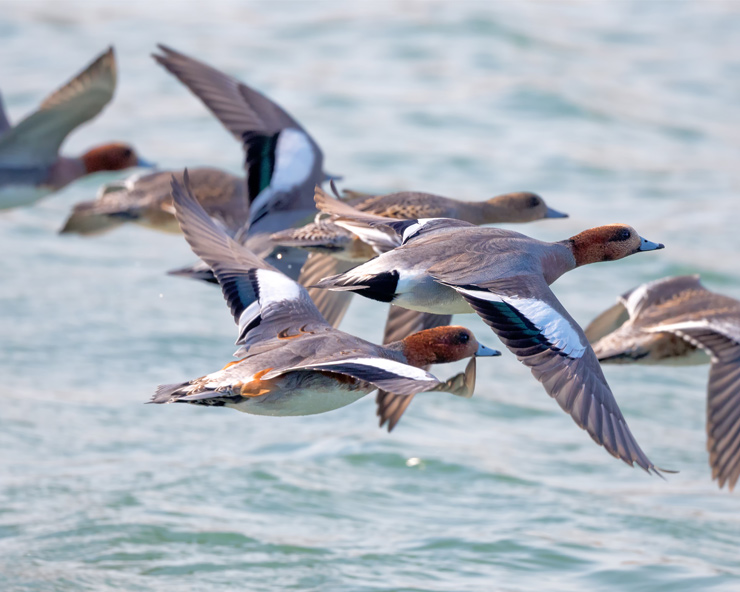If you follow current events, you’ve probably seen news of a large bird flu outbreak in Europe and Canada. Most recently, this strain of bird flu was discovered in a wild American Wigeon in South Carolina.
This disease is not limited to the large farms we often see on the news. Strains of the virus are currently circulating in the wild waterfowl population. As organic and alternative producers, we need to know about this disease to protect our flocks.
What is Bird flu?
Bird flu, also known as avian influenza, can affect many birds including wild waterfowl, pet birds, and domestic poultry. There are low pathogenic strains (LPAI) and high pathogenic strains (HPAI). Our focus is on highly pathogenic avian influenza because of its highly contagious and deadly nature.
Why are these outbreaks so concerning?
The United States is vigilant in the surveillance for bird flu, and for a good reason. Bird flu is highly infectious due to its ability to survive in the environment at cool temperatures for long periods. Once infected flocks are detected, they are depopulated to prevent spread to neighboring flocks.
How is Bird flu spread?
The Bird flu virus survives best in birds. Several species of wild waterfowl seem to have the ability to carry the virus without negative effects. This makes them the perfect vessel to carry the virus, allow it to mutate, and then spread to domestic poultry.
The virus is spread through close direct contact. This can be from bird to bird or through the ingestion of contaminated feces or respiratory droplets. Due to its ability to survive on surfaces for long periods, objects that become contaminated can spread the virus to other flocks quickly. These factors are particularly problematic for organic and alternative farmers as most of the birds we raise are outside, free to exhibit their natural behaviors where they can potentially contact wild waterfowl.
What does bird flu look like in poultry?
Birds infected with bird flu will appear dull, with dirty, unkempt feathers. They may have watery diarrhea that is often bright green that progresses to pale, almost white. Most birds will be depressed, go off feed, and water and hens will produce noticeably fewer eggs. Their combs may become blue and swollen. Sudden death can occur. This disease can affect the brain on rare occasions, and you may see head twisting, circling, or paralysis.
Can I get Bird flu?
While mammals, including humans, can become sick from Bird flu, it typically requires close contact with the infected birds. If infected, usually people will only have mild symptoms. These may include swollen red eyes or flu-like symptoms. Rarely it can be deadly to humans. To help protect yourself, it is best to wear masks, gloves, and safety glasses when working with birds that appear sick.
What can I do to prevent illness in my flock?
With the highly infectious nature of this virus, it may seem daunting to try to prevent it. However, even putting in place small measures can play a big role in prevention.
Try your best to limit any contact between your poultry and wild waterfowl. Good husbandry and frequent cleaning and disinfecting of your facility and equipment can prevent the build-up of germs, like bacteria and viruses. This is especially helpful in the case of fomites, which are objects that could be contaminated with the virus. If visitors or employees have had contact with other birds, make sure they wear clean clothes to your farm. Dirty hands, boots, or equipment can spread the virus from flock to flock.
Remember, it is always important to pay close attention to the behavior of your animals. Birds separating themselves from the flock can often be an early sign of illness. Watch for this and any of the signs described above to help you identify a problem early and lessen the consequences.
Suspect Bird flu in your flock?
It is always best to exercise caution if you see sick birds in your flock. Wear proper protective clothing and equipment, and be sure to wash your hands after touching sick animals to prevent yourself from becoming ill. If you are seeing any of the signs described above in your flock, contact your veterinarian (or extension agent or State Animal Health Official) as soon as possible. The faster the problem is identified, the sooner it can be controlled.
More Information on Bird flu:
Avian Influenza World Organization for Animal Health
Defend the Flock – Resource Center USDA
Fast Facts – Avian Influenza The Center for Food Security & Public Health
Avian influenza: assessing the pandemic threat World Health Organization
Thousands of birds killed amid ‘biggest ever outbreak of bird flu in Britain’ National History Museum
USDA Confirms Highly Pathogenic Avian Influenza in a Wild Bird in South Carolina USDA APHIS

